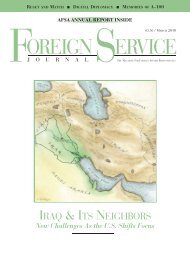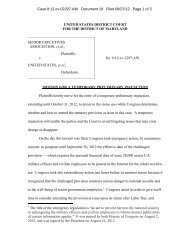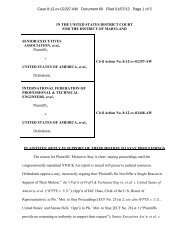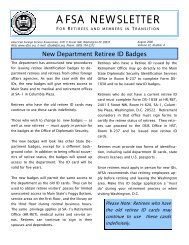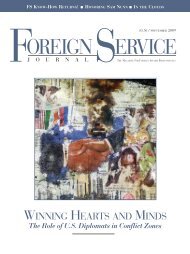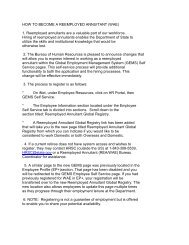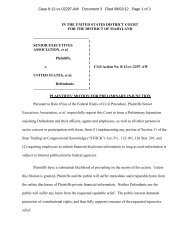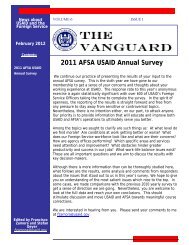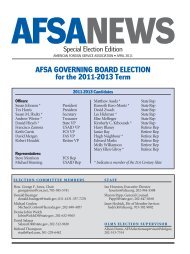F OCUS - American Foreign Service Association
F OCUS - American Foreign Service Association
F OCUS - American Foreign Service Association
Create successful ePaper yourself
Turn your PDF publications into a flip-book with our unique Google optimized e-Paper software.
he United States is currently<br />
employing all elements of national power to help<br />
Afghanistan overcome the legacy of three decades of war<br />
and to keep it from ever again serving as a launching pad<br />
for terrorism. For those of us here, every day is a 9/11<br />
anniversary. As a constant reminder of our task, two<br />
small memorial stones in front of Embassy Kabul mark<br />
the resting place of rubble from the Twin Trade Towers.<br />
Our strategy is focused on three main efforts: improving<br />
security, fostering economic development and<br />
strengthening governance.<br />
Our challenges are formidable. By comparison with<br />
Iraq, Afghanistan is larger and more populous, possesses<br />
a forbidding topography and a monumental narcotics<br />
problem, and is profoundly poor. The effort is made<br />
even more difficult by the lack of infrastructure and by<br />
weakened and distorted societal institutions. Finally, we<br />
face a hodgepodge of insurgent groups, including the<br />
Taliban, derivative Soviet-era resistance groups, crossborder<br />
tribes and al-Qaida.<br />
While our goal is to help build Afghanistan into a<br />
F <strong>OCUS</strong> ON A FGHANISTAN<br />
PRTS INAFGHANISTAN:<br />
A REPORT FROM THE INSIDE<br />
T<br />
Bruce Rogers is director and Robert Kemp is deputy<br />
director of the Provincial Reconstruction and Local<br />
Governance Section in Embassy Kabul, while Jim Hope is<br />
director of the USAID PRT Section there.<br />
THE CHALLENGES FOR AMERICAN POLICY IN<br />
AFGHANISTAN, WHERE THE PROVINCIAL RECONSTRUCTION<br />
TEAM CONCEPT WAS BORN, REMAIN FORMIDABLE.<br />
BY BRUCE ROGERS, JIM HOPE AND ROBERT KEMP<br />
nation that can serve as a force for regional stability,<br />
warfighting is still a major part of our activity.<br />
Approximately 28,000 U.S. troops, split between Operation<br />
Enduring Freedom and the International Security<br />
and Assistance Force, and 28,000 NATO/ISAF troops<br />
are deployed around the country to fight the insurgency<br />
and provide the security necessary to ensure the furtherance<br />
of governance and development.<br />
Combat power alone, however, will not lead us to our<br />
desired end-state. Its role is to separate the population<br />
from the insurgents, providing space for the extension of<br />
good government, provision of essential services and<br />
stimulation of economic development — our most<br />
potent weapons.<br />
Our Asymmetric Advantage<br />
There has been much ink spilled over the last seven<br />
years about how the enemy wages “asymmetric warfare”<br />
against us. In his book The Utility of Force: The Art of<br />
War in the Modern World (Vintage, 2008), British<br />
General Rupert Smith notes that asymmetry simply<br />
means that one side doesn’t play to the other side’s<br />
strengths. It is, moreover, a strategy that both sides can<br />
employ. For their part, the insurgents use terror to bring<br />
about their dark vision of an order imposed by the gun<br />
according to half-understood tenets of Islamic law. This<br />
JULY-AUGUST 2008/FOREIGN SERVICE JOURNAL 31



